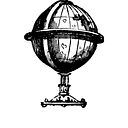The Designer’s Growth Model
The growth of a designer, i.e. the maturity of design, goes through several phases. Different phases ask different things of a designer. In each phase the work and goal of a designer changes. In each phase, the maturity grows.
Borrowing from the Invision report The New Design Frontier and the Greiner growth model (good designers copy, great designers steal), I concocted a model for the evolution of the designer. Just like the famous Greiner growth model, my model has different phases. I also have crises marking the transition from one phase to the next (never waste a good crisis). I reshuffled the order of the maturity model of Invision a little bit. If I remix the two (everything is a remix), I arrive at the following model.
Phase 1: Producers
The start of design is creating beautiful artifacts. It’s the foundational skill for designers. It’s what is taught in art school. It’s why designers become designers: to create beauty. It’s what makes design appealing. It’s what most people think of when they think about design. It’s what is shown in a museum when the theme is design: the designer as the producer of beautiful stuff. The tools are the classical design tools of Adobe. The skills are aesthetics: layout, whitespace, rhythm, color, form. Growth comes from mastery of the tools and learning to create more beautiful stuff.
Crisis 1: Scale
The first moment of crisis comes when the designer is successful. The better designers get, the bigger the projects they can work on become. They have to collaborate with more people and design systems on a larger scale. They need tools that help them collaborate and tools that help them design systems instead of single artifacts. They need to add collaboration and thinking in systems to their skillset. For a producer that has been trained to work solo on a single artifact in art school and that has mastered this craft, this is quite a hurdle.
Phase 2: Architects
When designers have cleared the hurdle of collaboration and thinking in systems, they become architects. They now work with large teams of designers and designs systems instead of artifacts. They use modern design tools that facilitate collaboration and the design of systems. Growth comes from better collaboration and mastery of thinking in systems.
Crisis 2: Co-creation
Architect work with designers. They design beautiful solutions based on design briefs. Design is still isolated from the rest of the business. It’s bigger than the production of single artifacts. The design has more impact because the scale is larger. Design is higher on the strategic agenda. But it’s done by designers on an assignment, on specifications from the business. If they are aiming for more impact, the next hurdle they have to take is opening up the design process to all the stakeholders of the problem that needs to be solved. They need to become a problem-solver instead of a producer of designs. For a designer to allow other people into his process is a big leap.
Phase 3: Connectors
If designers can connect to all the stakeholders and develop facilitation skills, they can create far better solutions. If they know the problems and needs of all stakeholders, they can have a far greater impact with his designs. One of the important stakeholders is the user but there are others. Designers are in an ideal starting position to connect the needs of the user to the needs of business and the possibilities of technology. They need to develop facilitation skills to organize and guide workshops, they need to develop the skill to use design prototypes to help the process of problem-solving, they need to understand the language of business and technology in order to smooth communications.
Crisis 3: Complexity crisis
When designers are able to be the bridge between user needs, business needs, and technological options, when they are able to collect insights, they can design solutions that are better aligned to the interest of all stakeholders. This will make his designs far more successful. This is great until they run into the next hurdle. The next hurdle is complexity. Even if you have done all the research, collected all the insights you can get from workshops and prototyped your way through communication problems, you run into the fact that the reality of your problem is too complex to design a solution and then go on an develop it. Development of large scale designs takes a lot of time and money and in a complex world, in the end, most of the solutions that are designed simply don't work well enough, simply don't deliver enough value. Either the world has changed once your design is delivered or it turns out people don’t behave as you thought. To solve this, designers have to get scientific: create hypotheses, design experiments and analyze the results. They have to shift from designing to solve to designing to learn. For an artistic designer, this shift to a more scientific, analytical approach can be a big mind-shift.
Phase 4: Scientists
Scientists are able to use their design skills alongside their analytical skills to iterate forward, to learn, to adapt. They are able to build, measure and learn and applies his unique designer’s perspective, mindset and skillset to lift projects to a higher level. Their hybrid approach of artistic design combined with analytical science enables them to create more value in projects while reducing risk and boosting performance. They use their prototypes to collect insights, to validate the direction and to guide the development process. The visual thinking, the ability to create concrete things, their creativity, their boldness, their ability to see connections all contribute to the quality and success of projects. They no longer execute assignments but recreates them, transforms them into engaging, successful journeys. Because the right problems are solved with solutions that are continuously validated, the scientist-designer creates an enormous amount of value. With the alternative futures they design, they are able to move people. And when they discover their superpower, they will want more. They will want to defeat the final hurdle. They will want the ultimate impact: to move people with their vision.
Crisis 4: Leadership crisis
That is when they face the final crisis. They need to up their leadership game. When they were architects, they were already leading design teams. But now the playing field has changed. They are no longer just impacting other designers, they are impacting entire organizations. They need to learn about organization and management, they need to understand how businesses work. This is not just about learning to speak the language as they learned when they became connectors. This goes one step further. They need to be able to design alternative organizations. They need to know how current managers think and work. In order to break the rules, they must first learn them. They must learn how to be a leader. They will be a different leader than the traditional MBA-trained leader but they must master the tricks of the trade.
Phase 5: Visionaries
The visionary can apply the skill-, mind-, and toolset to business challenges. Design brings a unique view to strategy, organization, leadership. Designers can transform organizations, create visions of the future, roadmaps to get there. Numbers and facts are not going to change organizations, a new image of the future will. There is a growing need for a new kind of leadership in organizations. A leadership that is based on imagination. A powerful image can be a huge force of change. Holistic thinking, boldness, creativity are what is needed in business today. And designers are in a great position to bring that to leadership.
That concludes the Designer’s Growth Model:
“There is no lack of money or technology, there is a lack of imagination and leadership.” — Daan Roosengaarde
Be sure to check out the original The New Design Frontier report from InVision and the Greiner growth model.
Thank you for taking the time to read this article. I hope you enjoyed it. If you did, don’t forget to hit the clap button. I will dive deeper into the topics of Design Leadership in upcoming articles. If you follow me here on Medium, you will see them pop up on your Medium homepage. You can also connect with me on LinkedIn to see new articles in your timeline or talk to my bot at dennishambeukers.com :)

